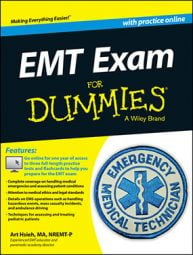The following practice questions are similar to the EMT exam’s questions about EMS operations. Read each question carefully, and then select the answer choice that best responds to the question.
Sample questions
You and your partner have just finished a shift and are off duty. The station pager goes off, signaling another call. No one is available to respond. Your partner does not want to go back in service. Which of the following statements is most correct?
(A)There is a duty to act, and you must respond.
(B)This may be an ethical issue, but not a legal issue.
(C)Good Samaritan laws will protect you in not responding.
(D)Your partner could be held liable for negligence.
A 55-year-old patient has sudden syncope. He is evaluated by EMTs at his home. He is alert, with pale, dry skin. He refuses their care and offer of transport. He subsequently experiences a cardiac arrest and dies. His family sues the EMTs for negligence. Which of the following statements is most correct?
(A)Because the EMTs failed to consider the potential seriousness of the condition and an injury occurred, they are liable.
(B)There was a breach of duty when the EMTs did not take the patient to the hospital.
(C)The patient has a right to self-determination and to make decisions about his care.
(D)There was no duty to encourage the patient to receive further medical care.
A 40-year-old female is at her office. She is confused, but cooperative. She is refusing your care and offer of transport. Her vital signs are normal and there are no obvious signs of illness or injury. You should
(A)advise her of possible negative outcomes of her decision.
(B)request police to respond.
(C)treat and transport.
(D)have coworkers transport her.
You are treating a 47-year-old female who is unresponsive, hypotensive, and breathing at a rate of four breaths per minute. One family member, who has power of attorney, wishes only supportive care for the patient. Several other family members are upset and begging you to begin resuscitation. You should
(A)move the patient to the gurney and begin transport.
(B)assist ventilations with a bag-valve mask and oxygen.
(C)contact police to question the family.
(D)administer supplemental oxygen.
You’re evaluating a patient with altered mental status when he becomes agitated and attempts to strike you. You should immediately
(A)step back and prepare to retreat if he becomes more violent.
(B)grab his arm and restrain him.
(C)have you and your partner grab his arms and torso.
(D)call for police assistance.
A patient has a fever and a productive cough. Your best way to avoid being infected is to
(A)have the patient be tested for serious airborne diseases.
(B)wash your hands after transporting the patient.
(C)place a mask over the patient’s face.
(D)wear eye protection.
After a call you note blood on the metal rails of the gurney, as well as the mattress. You should
(A)use hot water and soap to clean the affected areas.
(B)sterilize the gurney.
(C)use hand sanitizer to clean the rail and mattress.
(D)use a bleach-water solution to wipe down the gurney and mattress.
Your partner is tired, short-tempered, and treating his patients with disrespect. You are aware that he is having issues with his marriage and he has been working a lot of overtime. Which of the following ways of handling the situation would be most appropriate?
(A)Ignore the behavior, as the situation is none of your business.
(B)Report his behavior to the supervisor.
(C)Ask him how he is doing and offer to help.
(D)Talk with his wife to mediate a discussion with your partner.
You and your partner are preparing to remove a 300-pound patient from the third floor of a house. Which of the following approaches would be safest?
(A)Use a stair chair to carry the patient.
(B)Request that additional resources respond to the scene.
(C)Have family members assist you in moving the patient.
(D)Use the gurney to help move the patient.
While responding to an emergency call using lights and siren, you approach an intersection. The traffic light begins to change from green to yellow as you approach. You should
(A)slow down and prepare to stop if needed.
(B)speed up and proceed through the intersection before the light turns red.
(C)maintain your speed and prepare for an emergency maneuver if necessary.
(D)use your airhorn to clear the intersection.
Answers and explanations
B. Since you are off duty, and there is no expectation of your response, there is no legal duty to act in this situation.
C. There was a duty to act in this event — the EMTs were on duty and responded.
C. The patient does not have the capacity to make decisions.
A. The family member with power of attorney has the legal right to make decisions for the patient.
A. Your immediate maneuver is to avoid being injured.
B. The single best way to reduce cross contamination is to wash your hands, even if you wear gloves.
D. There may be more, smaller amounts of contaminant on the gurney than you can see.
C. Your partner is exhibiting signs of stress, which are showing up in his treatment of his patients.
B. The weight of the patient is too much for two rescuers to carry safely.
A. Driving with lights and siren is risky. Minimize the danger by slowing your forward speed before entering the intersection.

